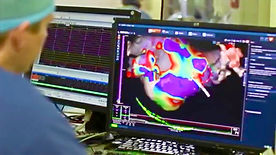CATHETER ABLATION FOR AF
WHAT IS IT?

Catheter ablation is a procedure that uses special wires that are advanced into the heart to give treatment to abnormal electrical impulses that cause heart rhythm problems (arrhythmias).
In people who experience AF, the treatment is directed around the pulmonary veins (blood vessels bringing blood back from the lungs to the heart) where they connect to the left atrium (left top chamber of the heart). Research has shown that most abnormal electrical impulses that trigger episodes of atrial fibrillation come from this region of the heart.

WHY PERFORM ABLATION FOR AF?

Some people continue to experience significant symptoms from their AF despite having tried several medications and other treatments such as cardioversions. Catheter ablation is a relatively new treatment, which is effective at controlling or possibly even curing atrial fibrillation in such people.
HOW SUCCESSFUL IS ABLATION FOR AF?
The success rates of this type of treatment for restoring and maintaining normal heart rhythm for at least 1 year are greater than 70% in people who are having intermittent episodes of AF.
The success rates are lower if the heart has been in AF persistently for some time (see Types of AF).
The likely success rates need to be determined on an individual basis according to a person's cardiac history and other health conditions. The definition of success may also change depending on whether the aim is to be completely free of AF or to have the AF "well controlled" over time for long term health benefits.
Several techniques for catheter ablation for atrial fibrillation have been developed around the world with varying success rates according to technique and the amount of training and experience of the Cardiologist performing the procedure.
Small numbers of patients can get their AF back over time, in which case medications can be retried or a repeat procedure can be performed to improve the success.
WHAT DOES THE PROCEDURE INVOLVE?

The procedure is performed under a general anaesthetic in a special operating theatre called the Cardiac Catheterisation Laboratory. While the patient is asleep, small incisions are made in both groins and several catheters are passed up through the veins into the heart. Small punctures are made from inside the heart to advance the catheters across into the left atrium where the treatment will be delivered. Intracardiac echocardiography (a special ultrasound wire used to take pictures from inside the heart) is used to visualise and aid the punctures.
First, information is collected with the catheters from the inside of the heart with the assistance of a 3D mapping system (‘GPS’ technology to reproduce the heart chambers and recreate heart rhythm circuits which enables a virtual 3D model of the heart and its electricity) and/ or also from the intracardiac echo imaging. Then ablation treatment is performed around each of the connections of the pulmonary veins with the left atrium. Information is then recollected to ensure that electrical impulses are no longer able to exit from inside of the pulmonary veins to trigger AF (so called “pulmonary vein isolation”). Other areas of the heart will be checked for abnormal electrical impulses, which could cause AF, and additional treatment may be performed.
At the completion of the procedure pressure is applied to seal over the incisions. The patient is taken to recovery and then back to a ward bed for monitoring overnight.
An important safety aspect of the procedure is preventing blood clot from forming on the catheters during the procedure, or inside the heart during the healing period, which could potentially travel off in the bloodstream and cause a stroke. Patients are required to take anticoagulation treatment for two months after the procedure, and sometimes before. Additional blood thinners are used during the ablation procedure.


